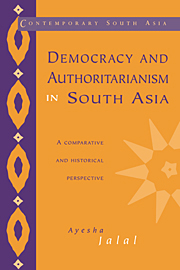Book contents
- Frontmatter
- Contents
- List of maps
- Preface
- Introduction
- 1 The colonial legacy in India and Pakistan
- 2 State formation and political processes in India and Pakistan, 1947 to c.1971
- 3 The ‘populist’ era and its aftermath in India, Pakistan and Bangladesh, 1971 to c.1993
- 4 The state and political economy, 1947 to c.1993
- 5 Central power and regional dissidence
- 6 Societies, cultures and ideologies: hybrids in contrived monoliths
- 7 Conclusion
- Bibliographical essay
- Index
2 - State formation and political processes in India and Pakistan, 1947 to c.1971
Published online by Cambridge University Press: 26 October 2009
- Frontmatter
- Contents
- List of maps
- Preface
- Introduction
- 1 The colonial legacy in India and Pakistan
- 2 State formation and political processes in India and Pakistan, 1947 to c.1971
- 3 The ‘populist’ era and its aftermath in India, Pakistan and Bangladesh, 1971 to c.1993
- 4 The state and political economy, 1947 to c.1993
- 5 Central power and regional dissidence
- 6 Societies, cultures and ideologies: hybrids in contrived monoliths
- 7 Conclusion
- Bibliographical essay
- Index
Summary
A compelling yet under-investigated question in contemporary South Asian history is why the partitioned inheritance of the British raj resulted in a different balance between state structures and political processes in post-independence India and Pakistan. A matter of wide and often imaginative speculation, it has invited explanations owing more to the predilections of specific schools of thought than to an actual examination of the historical factors that have contributed to making India a democratic polity and Pakistan a military dominated state.
Those steeped in the liberal democratic tradition have stressed the unique organizational phenomenon of the Indian National Congress. This is seen to have provided India's founding fathers, generally regarded as men of considerable political acumen and vision, with the institutional support necessary to lay the foundations of a stable, liberal democratic state. Marxist theorists for their part have sought explanations in the ‘overdeveloped’ institutional legacies of the colonial state and the corresponding weaknesses of dominant classes in civil society. Shades of determinism have clouded both interpretations. Long experience of working together in the antiimperialist struggle had been more conducive to understandings among the top leaders of the Indian National Congress than was the case with the Muslim League, a communal party with no real organizational existence in Muslim India before the final decade of the British raj. Yet placed in identical circumstances after independence it is debatable whether the Indian leadership would have done much better at institutionalizing representative democracy than their supposedly less able counterparts in Pakistan.
- Type
- Chapter
- Information
- Democracy and Authoritarianism in South AsiaA Comparative and Historical Perspective, pp. 29 - 65Publisher: Cambridge University PressPrint publication year: 1995

